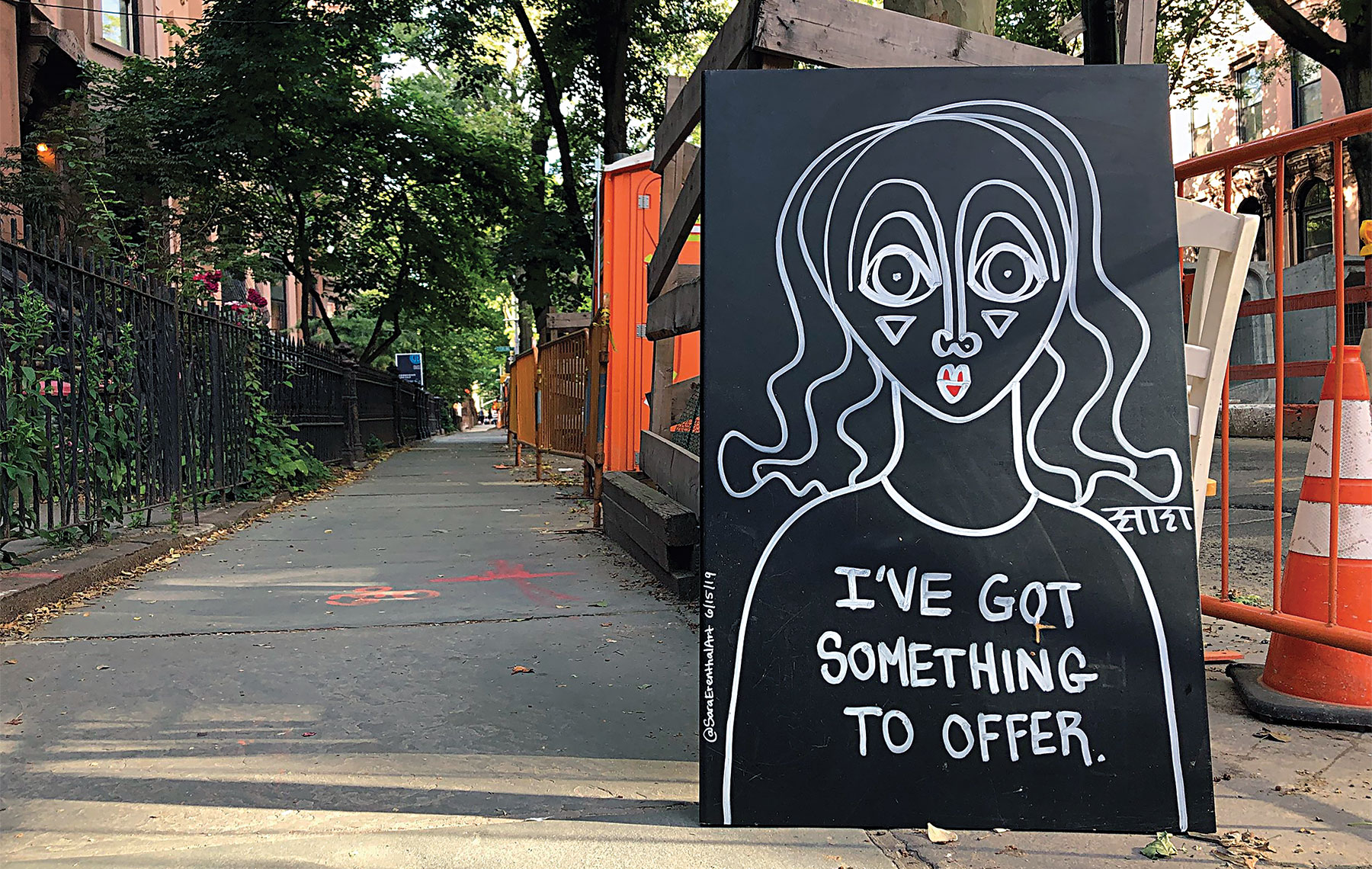
With phrases such as “Move forward,” “Listen carefully,” “Make art from your heart” and “Woman, speak up,” Sara Erenthal invites observers of her art to contemplation, if not action.
Erenthal upcycles found objects, everything from abandoned furniture and scrap wood to refrigerators and mattresses, then paints on them faces in black and white with large eyes and bright red lips. Her style is minimalistic and easily identifiable. Her portraits can be found from Los Angeles to New York, Berlin to Tel Aviv, as murals and on phone booths and mailboxes.
Self-taught, Erenthal displays her work on Instagram, sells studio pieces to private collectors and exhibits, and completes commissions internationally — all standard artist fare. But making public art is a radical departure from her upbringing.
Raised Ultra-Orthodox both in Israel, where she was born, and in New York, where her family later moved, her father subscribes to Neturei Karta, an ultra-Orthodox sect that opposes the creation of a modern Jewish state before the coming of the messiah.
At 17, when Erenthal’s parents arranged for her to marry a man she had never met, she ran away to relatives and enlisted in the Israeli army. During her service, she dropped her native Yiddish for contemporary Hebrew and began identifying as a secular Jew. Almost a decade after her discharge, she explored India, where she began drawing. That influence remains. Her works include what looks like the word “Art” somewhere on the right of most of her images. It is actually her signature in Sanskrit.
The Journal caught up with the Brooklyn-based Erenthal to discuss her work and her influences.
Jewish Journal: Your work focuses on themes of displacement, survival and liberation. Why do you call your trademark image a subconscious self-portrait?
Sara Erenthal: To me, it represents a feeling. It’s not literally me. It’s more of an emotion. I feel like that’s subconsciously me but it also represents women in general and also humanity. It’s very raw.
JJ: How do you describe her?
SE: That’s up to the viewer to interpret.
JJ: What do your images express?
SE: They tend to express my daily experiences, everything about life. Sometimes it’s really personal, sometimes less, sometimes political.
JJ: Your work appears in many different parts of L.A. How did that happen? And how much is here?
SE: I was there for 10 days in December 2018. Between posters and drawing on discarded objects and other little things, I must have made somewhere from 50 to 100 pieces.

JJ: How many pieces have you made? Do you have any favorites?
SE: I have made thousands of pieces. Everything is my favorite because it’s all things that I need to express and what I’m going to through.
JJ: What prompted you to explore sexual themes?
SE: At this point in my life, I understand that it’s important for me to be truthful about reality. I see no limits of what I can express in my art. Life comes with all these experiences and sexuality is part of it. And lately, I am trying to be more open about that. People are afraid to talk about certain things, but I don’t see why we shouldn’t talk about it.
JJ: How would you characterize your work style?
SE: I’m always pushing myself and trying to outdo myself. Because I’ve been doing it for a while, I’m always hoping to grow and evolve and get better.
JJ: When do you work best?
SE: I’m nocturnal. I definitely have a lot more energy later in the day. It takes me a while to get myself to a place where I want to communicate or work with other people. It’s a slow process for me to get myself together. When I have a solo show or a mural [or] an international project and I have to finish by a certain time, it’s all open-ended.
JJ: How do you prepare before you visit a new place?
SE: I prepare a couple of different pieces that are ready to go, flyers or posters. Then it’s guerrilla art. [I post them] on a TV, the back side of an old shelf, a mirror, a refrigerator. Anything that is not someone’s property is fair game for me.
JJ: Which street artists inspire you?
SE: I think Banksy is an interesting artist. I am inspired by everyone who creates. I don’t like the label street artist. I like the term multidisciplinary artist. Public art to me is a really nice term because it makes art accessible to everyone and without any institution. You get to make your own choice of what you want people to see.
JJ: You posted a video of someone sawing a wooden piece you had previously painted. What are some of the strangest experiences you’ve had when it comes to your art?
SE: The most outrageous thing that has happened — it’s not that I did something outrageous — was someone cutting up mattresses to save the fabric with my art on it. I think about a mattress, what it’s been through. A lot of people ask me if I’m afraid of bed bugs.
JJ: Are you?
SE: No. But I wouldn’t bring [a mattress] into my home. For me, what is the most entertaining is the lengths people will go to have my art that they find. It’s also a huge compliment.
Corrections: A previous version of this article incorrectly stated the following: Erenthal was raised Chasidic; that she could have chosen to turn down a marriage proposal; and that she traveled to India immediately after leaving the army.
Lisa Klug is a freelance journalist and the author of “Cool Jew” and “Hot Mamalah: The Ultimate Guide for Every Woman of the Tribe.”























 More news and opinions than at a Shabbat dinner, right in your inbox.
More news and opinions than at a Shabbat dinner, right in your inbox.